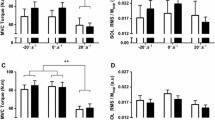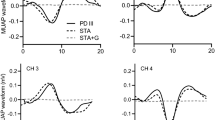Abstract
A substantial gain in strength is often observed in the early phase of resistance training. The aim of this study was to address whether improved strength in the early phase of resistance training, can be attributed to increased activation, or to intra-muscular changes of the agonist muscle during maximal isometric torque production. Fourteen male subjects trained maximal isometric dorsiflexion during 5 days. Each subject performed 9 sessions with 25 maximal voluntary contractions in a device that registered the dorsiflexion torque. Surface electromyography (SEMG) of the tibialis anterior (TA) was recorded with a 130-channel grid electrode. SEMG of the extensor digitorum longus, gastrocnemius and soleus muscles were recorded with bipolar electrodes. The main finding was that all subjects gained in strength while the SEMG activation level of the primer agonist, TA, decreased with no apparent intra-muscular spatial changes following 5 days of resistance training. The other muscles that influence dorsiflexion torque did not modify their activation level with training. These findings reject an increase in agonist activation level as the main source for early strength gain, and illustrate the need for further research to reveal the specific sites of neural adaptation and other physiological mechanisms that might contribute to increased strength during the early phase of resistance training.






Similar content being viewed by others
References
Basmajian J, De Luca CJ (1985) Muscles alive. Their functions revealed by electromyography. Williams & Wilkins, Baltimore
Bilodeau M, Schindler-Ivens S, Williams DM, Chandran R, Sharma SS (2003) EMG frequency content changes with increasing force and during fatigue in the quadriceps femoris muscle of men and women. J Electromyogr Kinesiol 13:83–92
Bobbert MF, van Ingen Schenau GJ (1990) Isokinetic plantar flexion: experimental results and model calculations. J Biomech 23:105–119
Bottinelli R, Canepari M, Reggiani C, Stienen GJ (1994) Myofibrillar ATPase activity during isometric contraction and isomyosin composition in rat single skinned muscle fibres. J Physiol 481:663–675
Carroll TJ, Riek S, Carson RG (2001) Neural adaptations to resistance training: implications for movement control. Sports Med 31:829–840
Chilibeck PD, Calder AW, Sale DG, Webber CE (1998) A comparison of strength and muscle mass increases during resistance training in young women. Eur J Appl Physiol 77:170–175
Claassen H, Gerber C, Hoppeler H, Luthi JM, Vock P (1989) Muscle filament spacing and short-term heavy-resistance exercise in humans. J Physiol 409:491–495
Cram JR, Kasman GS, Holtz J (1998) Introduction to surface electromyography. Aspen Publishers, Maryland
De Luca CJ (1997) The use of surface electromyography in biomechanics. J Appl Biomech 13:135–163
Enoka RM (2002) Neuromechanics of human movement. Hum Kinet
Gibala MJ, MacDougall JD, Tarnopolsky MA, Stauber WT, Elorriaga A (1995) Changes in human skeletal muscle ultrastructure and force production after acute resistance exercise. J Appl Physiol 78:702–708
Hakkinen K, Kallinen M, Izquierdo M, Jokelainen K, Lassila K, Malkia E, Kraemer WJ, Newton RU, Alen M (1998) Changes in agonist-antagonist EMG, muscle CSA, and force during strength training in middle-aged and older people. J Appl Physiol 84:1341–1349
Hermens HJ, Fredriks B, Merletti R, Stegeman D, Blok J, Rau G, Disselhorst-Klug C, Hagg G (1999) European recommendations for surface electromyography. Roessingh Research and Development b.v., Enschede
Holtermann A, Roeleveld K, Karlsson SJ (2005) Inhomogeneities in muscle activation reveal motor unit recruitment. J Electromyogr Kinesiol 15(2):131–137
Kubo K, Tsunoda N, Kanehisa H, Fukunaga T (2004) Activation of agonist and antagonist muscles at different joint angles during maximal isometric efforts. Eur J Appl Physiol 91:349–352
Milner-Brown HS, Stein RB, Lee RG (1975) Synchronization of human motor units: possible roles of exercise and supraspinal reflexes. Electroencephalogr Clin Neurophysiol 38:245–254
Ørtenblad N, Lunde PK, Levin K, Andersen JL, Pedersen PK (2000) Enhanced sarcoplasmatic reticulium Ca2+ release following intermittent sprint training. Am J Physiol, Regul, Integr Comp Physiol 279:152–160
Phillips ST (2000) Short-term training: when do repeated bouts of resistance exercise become training? Can J Appl Physiol 25:185–193
Pousson M, Amiridis IG, Cometti G, van Hoecke J (1999) Velocity-specific training in elbow flexors. Eur J Appl Physiol 80:367–372
Roeleveld K, Stegeman DF, Falck B, Stålberg EV (1997) Motor unit size estimation: confrontation of surface EMG with macro EMG. Electroencephalogr Clin Neurophysiol 105:181–188
Roeleveld K, Sandberg A, Stålberg EV, Stegeman DF (1998) Motor unit size estimation of enlarged motor units with surface electromyography. Muscle Nerve 21:878–886
Rutherford OM, Jones DA (1986) The role of learning and coordination in strength training. Eur J Appl Physiol 55:100–105
Sale DG (2003) Neural adaptation to strength training. In: Komi PV (ed) Strength and power in sport. Blackwell, Oxford, pp 281:314
Sandercock TG, Heckman CJ (1997) Doublet potentiation during eccentric and concentric contractions of cat soleus muscle. J Appl Physiol 82:1219–1228
Schumann NP, Biederman FHW, Kleine BU, Stegeman DC, Roeleveld K, Hackert R, Scholle HC (2002) Multi-channel EMG of the M. triceps brachii in rats during treadmill locomotion. Clin Neurophysiol 113:1142–1151
Solomonow M, Baten C, Smit J, Baratta R, Hermens H, D‘Ambrosia R, Shoji H (1990) Electromyogram power spectra frequencies associated with motor unit recruitment strategies. J Appl Physiol 68:1177–1185
Van Cutsem M, Duchateau J, Hainaut K (1998) Changes in single motor unit behavior contribute to the increase in contraction speed after dynamic training in humans. J Physiol 513:295–305
Yue G, Cole KJ (1992) Strength increases from the motor program: comparison of training with maximal voluntary and imagined contractions. J Neurophysiol 67:1114–1123
Acknowledgements
We would like to thank the Medical technical research center, Medical faculty, NTNU, for partially funding this project. Einar Hassel, Human Movement Sciences program, NTNU, for construction of the strength-recording device, and Paul Jarle Mork, Department of Industrial Economics and Technology, NTNU, for constructive comments and discussion.
Author information
Authors and Affiliations
Corresponding author
Rights and permissions
About this article
Cite this article
Holtermann, A., Roeleveld, K., Vereijken, B. et al. Changes in agonist EMG activation level during MVC cannot explain early strength improvement. Eur J Appl Physiol 94, 593–601 (2005). https://doi.org/10.1007/s00421-005-1365-9
Accepted:
Published:
Issue Date:
DOI: https://doi.org/10.1007/s00421-005-1365-9




